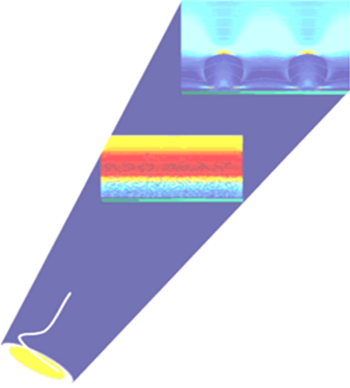Soft, Structured Layers on the Surface of a Quartz Crystal Microbalance (QCM): A Computational Model to Predict Shifts of Frequency and Bandwidth Based on the Lattice-Boltzmann Method
Soft, Structured Layers on the Surface of a Quartz Crystal Microbalance (QCM): A Computational Model to Predict Shifts of Frequency and Bandwidth Based on the Lattice-Boltzmann Method
Building on a linearized variant of the Lattice Boltzmann Method (termed Frequency-Domain Lattice-Boltzmann Method), a simulation package shall be developed, which models the behavior a quartz crystal microbalance (QCM) in contact with structured samples in the liquid phase. While the method shall be applicable to samples with arbitrary shape, this work shall focus on particulate adsorbates with a thickness much below the wavelength of sound (such adsorbed globular proteins). Among the parameters to be varied is the coverage. The parameters to be predicted are the shifts of resonance frequency and resonance bandwidth on the different overtones of the resonator. Analytical models predicting these parameters exist for planar layer systems, but not for laterally heterogeneous samples. A first step shall be to quantify the contribution of the liquid mass trapped between adsorbed particles to the overall apparent mass, where the latter is calculated from the frequency shift with the (very simple) Sauerbrey equation. Particles of variable size, shape, and orientation shall be randomly deposited on the resonator surface, where the algorithm doing so shall allow for clustering. A second step shall be to study the consequences of a finite compliance of the contact between the particle and the substrate. Finite compliance is expected to increase the resonance bandwidth. This expectation shall be tested and be turned into a quantitative prediction. Strategies for inversion shall be identified: For certain configurations of practical importance, rules shall be derived, which allow to infer parameters of the sample (such as the average height of the particles, the stiffness of link, or the degree of clustering) from the experimentally determined values as a function of overtone order and coverage. Later in the project, the code shall be improved with regard to the accuracy, by which the forces at the particle surfaces are obtained. This step will be important for the study of adsorbates with sizes comparable to the wavelength of sound. For the current code, such layers pose a technical problem, which can be circumvented if the layers are acoustically thin. Adsorbed particles with a thickness of the order of the wavelength of sound often display so-called coupled resonances. Coupled resonances can be viewed as adsorption lines in shear-wave spectroscopy. There is a far-reaching analogy to vibrational spectroscopy on molecules. In particular, there is a mode-assignment problem, meaning that a coupled resonance can be caused by different modes of motion of the adsorbed object. The mode assignment problem shall be solved by the proposed work. In particular, it shall be clarified for a given experimental example, whether the coupled resonance is caused by a rocking mode, which exerting a bending stress at the link, or a slipping mode which exerts a tangential stress.
